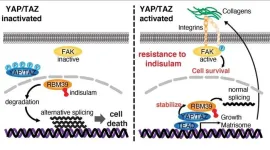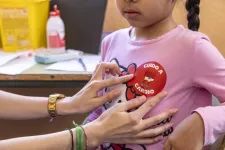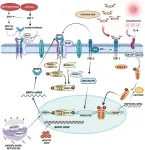(Press-News.org) Researchers at Brigham and Women’s Hospital, a founding member of the Mass General Brigham healthcare system, have developed a model that rapidly converts stem cells to brain cells with protein structures characteristic of Parkinson’s disease (PD), enabling the study of the condition’s unique and highly variable disease pathology in a petri dish. The study details how the model can one day be used to develop personalized diagnostic and treatment methods for Parkinson’s disease. Results are published in Neuron.
“We sought to assess how quickly we could make human brain cells in the lab that give us a window into key processes occurring in the brains of patients with Parkinson’s disease and related disorders like multiple system atrophy and Lewy body dementia,” said senior author Vikram Khurana, MD, PhD, chief of the Movement Disorders Division at BWH and principal investigator within the Ann Romney Center for Neurologic Diseases at BWH. “And, unlike previous models, we wanted to do this in a short enough timeframe for these models to be useful for high-throughput genetic and drug screens and easy enough for many labs to use across academia and industry.”
PD is a progressive and degenerative brain condition. Individuals with the disease often struggle with slowed movement, tremors, muscle stiffness, and speech impairment, among other health complications. PD, along with other neurodegenerative conditions like Alzheimer’s disease, causes protein build-up in neurons, leading to protein misfolding and impaired cell function. Current PD therapies can alleviate some symptoms but do not address the root cause of the protein misfolding.
Existing “Parkinson’s in a dish” models can effectively transform stem cells into brain cells, but not within a reasonable timeframe to study patient-specific cellular pathologies to guide tailored treatment strategies. This is important because patients with PD are diverse and a one-size-fits-all treatment strategy may now work for some patients. The Brigham research team’s technology not only enables the transformation from stem cells to brain cells to occur reproducibly within weeks instead of months, but also allows researchers to develop models that reflect the diverse protein misfolding pathologies that can occur in the brain in that timeframe.
“The problem is that the way protein clusters form in PD looks different in different patients, and even in different brain cells of the same patient,”said Khurana. “This begs the question: how do we model this complexity in the dish? And how do we do it fast enough for it to be practical for diagnostics and drug discovery?”
To create this model, Khurana’s lab used special delivery molecules called PiggyBac vectors to introduce specific cellular instructions, known as transcription factors, to quickly turn stem cells into different types of brain cells. They then introduced aggregation-prone proteins like alpha-synuclein, which is central to the formation of protein clusters in PD and related disorders, in nerve cells. Using CRISPR/Cas9 and other screening systems, they identified diverse types of inclusions forming in the cells, some of them protective and some of them toxic. To prove relevance to disease, they used their stem-cell models to discover similar inclusions in actual brains from deceased patients. The work enables new approaches for classifying protein pathologies in patients and determining which of these pathologies might be the best drug targets.
While marking progress, the model has several limitations researchers aim to address. For one, it currently generates immature neurons. The researchers aim to replicate this model with mature neurons to model the effects of aging on the protein aggregates that form. While the new system can rapidly create both neurons and key inflammatory “glial” cells in the brain, the current paper only examines these cells individually. The team is now combining these cells together to study the inflammatory responses to the protein aggregation process that might be important for PD progression.
The two lead authors on the study, both research fellows in the Department of Neurology at BWH, commented on the clinical applications that are already underway in the lab. “In one key application, we are utilizing this technology to identify candidate radiotracer molecules to help us visualize alpha-synuclein aggregation pathologies in the brains of living patients we see in the clinic,” said co-first author Alain Ndayisaba, MD.
“This technology will pave the way for rapidly developing ‘personalized stem cell models’ from individual patients. These models are already being used to efficiently test new diagnostic and treatment strategies ‘in a dish’ before jumping into clinical trials so we target the right drug to the right patient,” said co-first author Isabel Lam, PhD.
Authorship: Along with Vikram Khurana, Isabel Lam and Alain Ndayisaba, BWH authors include Anastasia Kuzkina, Ricardo L. Sanz, Aazam Vahdatshoar, Arati Tripathi, Nagendran Ramalingam, Charlotte Oettgen-Suazo, Manel Boussouf, Timothy D. Martin, Max Schäbinger, Erinc Hallacli, Amrita Verma, Xiao Yu, Kelly Hyles, Chansaem Park, Xinyuan Wang, Stephen J. Elledge, and Ulf Dettmer. Additional authors include Amanda J. Lewis, YuHong Fu, Giselle T. Sagredo, Ludovica Zaccagnini, Meral Celikag, Jackson Sandoe, Nader Morshed, Toru Ichihashi, Theresa Bartels, Xin Jiang, Challana Tea, Zichen Wang, Hiroyuki Hakozaki, Thorold W. Theunissen, Haoyi Wang, Rudolf Jaenisch, Susan Lindquist, Beth Stevens, Nadia Stefanova, Gregor Wenning, Wilma D.J. van de Berg, Kelvin C. Luk, Rosario Sanchez-Pernaute, Juan Carlos Gómez-Esteban, Daniel Felsky, Yasujiro Kiyota, Nidhi Sahni, S. Stephen Yi, Chee-Yeun Chung, Henning Stahlberg, Isidro Ferrer, Johannes Schöneberg, Glenda M. Halliday, and Tim Bartels.
Disclosures: Khurana is a cofounder of and senior advisor to DaCapo Brainscience and Yumanity Therapeutics, companies focused on CNS diseases. Chung and Jiang contributed to this work as employees of Yumanity Therapeutics. Ichihashi and Kiyota contributed to this work as employees of Nikon Corporation. Lam, Ndayisaba, Sandoe, and Khurana are inventors on a patent application filed by Brigham and Women’s Hospital related to the induced inclusion iPSC models.
Funding: National Institutes of Health (NIH), Aligning Science Across Parkinson’s (ASAP), Michael J. Fox Foundation, New York Stem Cell Foundation, Multiple System Atrophy Coalition, and private donors.
Paper cited: Lam I. et al. “Rapid iPSC inclusionopathy models shed light on formation, consequence and molecular subtype of α-synuclein inclusions.” Neuron DOI: 10.1016/j.neuron.2024.06.002
END
Advanced ‘Parkinson's in a dish’ model accelerates brain disease research
A new model developed by Brigham researchers rapidly converts stem cells to brain cells characteristic of Parkinson’s disease to create personalized stem cell models with opportunities to test treatments
2024-07-29
ELSE PRESS RELEASES FROM THIS DATE:
What will the new cardiovascular risk calculator mean for patients?
2024-07-29
A recently unveiled cardiovascular disease risk calculator that measures a patient’s risk for heart attack and stroke is better calibrated and more precise than its previous version, but if current treatment guidelines for cholesterol and blood pressure therapy remain unchanged, the new calculator may have unintended consequences, according to research from Harvard Medical School.
The analysis, published July 29 in JAMA, estimates that the new risk calculator would render nearly 16 million people newly ineligible under current treatment thresholds that guide clinical decisions about who should get cholesterol ...
Patients in hospitals that provide inpatient addiction services were more likely to start and continue lifesaving medication for opioid use disorder treatment after discharge
2024-07-29
Previous research has found that over 80 percent of people with opioid use disorder (OUD) do not receive evidence-based lifesaving medications. While access to these medications is better in New York City than elsewhere in the United States, numerous structural and social barriers impede access to treatment, and more than 100,000 people in the U.S. continue to die from drug overdoses each year.
To help close this alarming treatment gap, researchers at NYU Grossman School of Medicine partnered with the New York ...
Healthy diet with less sugar is linked to younger biological age
2024-07-29
Researchers at UC San Francisco have found a link between following a diet that is rich in vitamins and minerals, especially one without much added sugar, and having a younger biological age at the cellular level.
They looked at how three different measures of healthy eating affected an “epigenetic clock” – a biochemical test that can approximate both health and lifespan – and found that the better people ate, the younger their cells looked. Even when people ate healthy diets, ...
From tree holes to trash
2024-07-29
A team of biologists from the University of Delhi and Zoological Survey of India, Harvard University, and the University of Minnesota has discovered a unique breeding behavior in a species of frog endemic to the Andaman Islands of India. In a new study published in the Harvard Museum of Comparative Zoology’s journal Breviora, scientists describe a combination of traits that makes reproduction in this frog unique.
The Andamanese Charles Darwin’s frog, Minervarya charlesdarwini, belongs to the family Dicroglossidae, a large radiation of Asian frogs that comprises over ...
Despite risk, many unsure of temperature to heat food to prevent illness
2024-07-29
PHILADELPHIA – With bird flu virus detected in cow’s milk, U.S. health authorities have warned the public against potential sources of exposure, including drinking raw or unpasteurized milk, and have reiterated a general warning that consuming uncooked or undercooked poultry or beef products can make you sick.
Relatively few people say they drink raw milk. Only 3% of U.S. adults report having consumed raw milk in the past 12 months, while 4% were not sure whether they had, according to a new nationally representative Annenberg Public Policy Center health survey of nearly 1,500 empaneled U.S. adults conducted in July.*
But many more people say they do ...
YAP/TAZ interactions can confer resistance to anti-tumor drug indisulam
2024-07-29
In a healthy human body, tissue growth and development are coordinated by many different mechanisms. Within our bodies, these mechanisms regulate the healthy growth of cells, limit their size and number, and control the timing of cell death through apoptosis. However, when these regulatory pathways are altered, or break down, cell growth and proliferation may increase beyond what is safe and this can lead to cancer. One critical cell growth regulatory mechanism is the Hippo signaling pathway. This pathway regulates the expression of several genes that control cell proliferation ...
Asbestos-related cancer: exaggerated risk perception
2024-07-29
Asbestos, a group of naturally occurring fibrous minerals, has been historically used for its durability and resistance to heat. Despite its advantageous properties, asbestos is a well-documented carcinogen, linked to diseases such as lung cancer (LC) and malignant pleural mesothelioma (MPM). The controversy surrounding the degree of carcinogenicity of different asbestos types, especially chrysotile versus amphibole asbestos, continues to influence scientific and regulatory discussions. This review delves into the various aspects of asbestos-related research, focusing on historical context, risk assessment, environmental ...
Gropp, former NCSA leaders selected for HPCwire’s inaugural ‘35 Legends’ list
2024-07-29
NCSA Director Bill Gropp and two former Center directors were chosen for the first-ever HPCwire “35 Legends” list in celebration of the publication’s 35th anniversary.
Thirty-five honorees will be announced each year, selected by HPCwire editors and advisors based on their contributions to the high-performance computing community over the past 35 years and celebrated for the different ways they’ve helped move HPC forward.
Gropp, NCSA’s Founding Director Larry Smarr and Former Director Daniel Reed were among the first 17 honorees announced in July. The remaining HPCwire 35 Legends will be ...
The sooner the better: teaching healthy habits in elementary school reduces abdominal fat
2024-07-29
A study led by the Centro Nacional de Investigaciones Cardiovasculares (CNIC) and Fundación SHE, supported by “la Caixa” Foundation, demonstrates that teaching healthy habits through classroom activities helps to prevent the accumulation of abdominal fat during the first school years.
The study, published in the Journal of the American College of Cardiology (JACC), is one of the largest contemporary school-based health promotion studies and has one of the most extensive participant follow-up schedules.
The conclusions are clear: early intervention to promote healthy habits in elementary school children can be more ...
Exploring the impact of iron overload on mitochondrial DNA in β-thalassemia
2024-07-29
β-Thalassemia is a genetic disorder characterized by reduced or absent synthesis of the beta chains of hemoglobin, leading to ineffective erythropoiesis and severe anemia. Patients with transfusion-dependent β-thalassemia (TDT) require regular blood transfusions to maintain adequate hemoglobin levels. Non-transfusion-dependent thalassemia (NTDT) patients manage their anemia without regular transfusions but still experience significant health complications. Iron overload is a common and severe complication in both TDT and NTDT patients ...
LAST 30 PRESS RELEASES:
KIST develops eco-friendly palladium recovery technology to safeguard resource security
Statins significantly reduce mortality risk for adults with diabetes, regardless of cardiovascular risk
Brain immune cells may drive more damage in females than males with Alzheimer’s
Evidence-based recommendations empower clinicians to manage epilepsy in pregnancy
Fungus turns bark beetles’ defenses against them
There are new antivirals being tested for herpesviruses. Scientists now know how they work
CDI scientist, colleagues author review of global burden of fungus Candida auris
How does stroke influence speech comprehension?
B cells transiently unlock their plasticity, risking lymphoma development
Advanced AI dodel predicts spoken language outcomes in deaf children after cochlear implants
Multimodal imaging-based cerebral blood flow prediction model development in simulated microgravity
Accelerated streaming subgraph matching framework is faster, more robust, and scalable
Gestational diabetes rose every year in the US since 2016
OHSU researchers find breast cancer drug boosts leukemia treatment
Fear and medical misinformation regarding risk of progression or recurrence among patients with breast cancer
Glucagonlike peptide-1 receptor agonists and asthma risk in adolescents with obesity
Reviving dormant immunity: Millimeter waves reprogram the immunosuppressive microenvironment to potentiate immunotherapy without obvious side effects
Safety decision-making for autonomous vehicles integrating passenger physiological states by fNIRS
Fires could emit more air pollution than previously estimated
A new way to map how cells choose their fate
Numbers in our sights affect how we perceive space
SIMJ announces global collaborative book project in commemoration of its 75th anniversary
Air pollution exposure and birth weight
Obstructive sleep apnea risk and mental health conditions among older adults
How talking slows eye movements behind the wheel
The Ceramic Society of Japan’s Oxoate Ceramics Research Association launches new international book project
Heart-brain connection: international study reveals the role of the vagus nerve in keeping the heart young
Researchers identify Rb1 as a predictive biomarker for a new therapeutic strategy in some breast cancers
Survey reveals ethical gaps slowing AI adoption in pediatric surgery
Stimulant ADHD medications work differently than thought
[Press-News.org] Advanced ‘Parkinson's in a dish’ model accelerates brain disease researchA new model developed by Brigham researchers rapidly converts stem cells to brain cells characteristic of Parkinson’s disease to create personalized stem cell models with opportunities to test treatments




